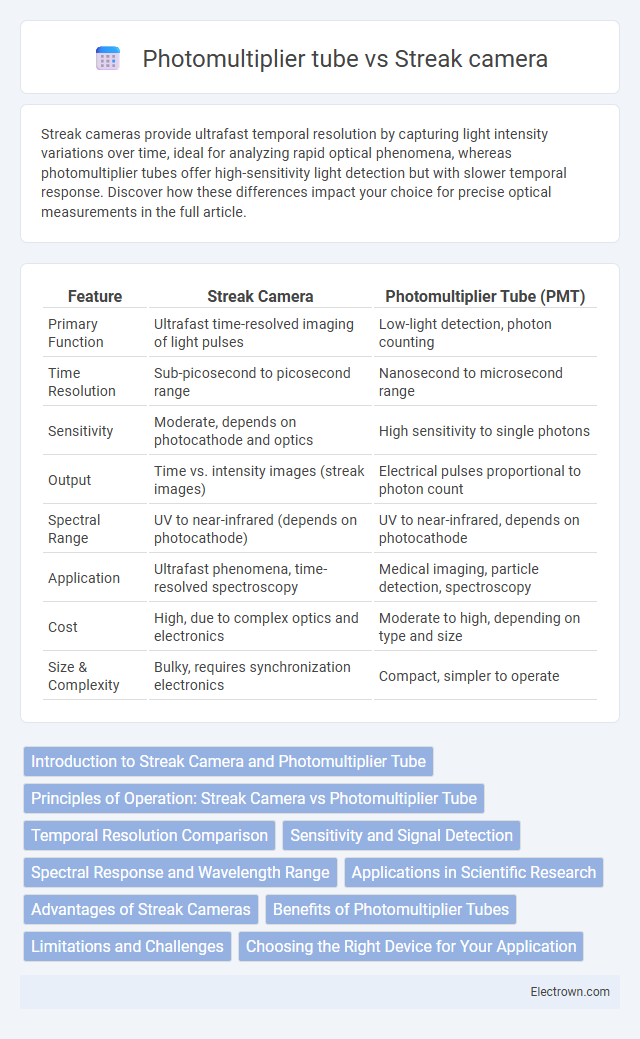Streak cameras provide ultrafast temporal resolution by capturing light intensity variations over time, ideal for analyzing rapid optical phenomena, whereas photomultiplier tubes offer high-sensitivity light detection but with slower temporal response. Discover how these differences impact your choice for precise optical measurements in the full article.
Table of Comparison
| Feature | Streak Camera | Photomultiplier Tube (PMT) |
|---|---|---|
| Primary Function | Ultrafast time-resolved imaging of light pulses | Low-light detection, photon counting |
| Time Resolution | Sub-picosecond to picosecond range | Nanosecond to microsecond range |
| Sensitivity | Moderate, depends on photocathode and optics | High sensitivity to single photons |
| Output | Time vs. intensity images (streak images) | Electrical pulses proportional to photon count |
| Spectral Range | UV to near-infrared (depends on photocathode) | UV to near-infrared, depends on photocathode |
| Application | Ultrafast phenomena, time-resolved spectroscopy | Medical imaging, particle detection, spectroscopy |
| Cost | High, due to complex optics and electronics | Moderate to high, depending on type and size |
| Size & Complexity | Bulky, requires synchronization electronics | Compact, simpler to operate |
Introduction to Streak Camera and Photomultiplier Tube
A Streak camera is an ultra-fast optical instrument that converts temporal variations of light into spatial information, enabling femtosecond to picosecond resolution in time-resolved spectroscopy. A Photomultiplier tube (PMT) is a highly sensitive photon detector that amplifies weak light signals through a cascade of electron multiplications, commonly used in fluorescence and scintillation detection. Your choice between these devices depends on the need for high temporal resolution with streak cameras or superior sensitivity and single-photon detection capabilities offered by PMTs.
Principles of Operation: Streak Camera vs Photomultiplier Tube
A streak camera operates by converting incoming photons into electrons, which are then deflected across a phosphor screen to provide a time-resolved image with picosecond resolution, enabling ultrafast optical event analysis. In contrast, a photomultiplier tube (PMT) amplifies incident photons via a cascade of electron multiplications through dynodes, resulting in a highly sensitive and rapid electrical signal ideal for low-light detection. While the streak camera excels in temporal resolution for capturing transient events, the photomultiplier tube is optimized for photon counting and intensity measurements with high gain and fast response.
Temporal Resolution Comparison
Streak cameras offer superior temporal resolution, reaching sub-picosecond levels, ideal for ultrafast phenomena capture, while photomultiplier tubes (PMTs) typically provide temporal resolution in the nanosecond range. The streak camera's ability to convert time into spatial information enables precise measurement of transient events, outperforming PMTs in time-resolved spectroscopy applications. PMTs excel in sensitivity and single-photon detection but lack the sub-picosecond temporal precision inherent to streak cameras.
Sensitivity and Signal Detection
Streak cameras offer high temporal resolution but generally lower sensitivity compared to photomultiplier tubes (PMTs), which excel in detecting low-intensity photons due to their high gain and quantum efficiency. PMTs provide superior signal detection in low-light conditions and are widely used in applications requiring single-photon sensitivity. In contrast, streak cameras are preferred for capturing ultrafast transient events despite their comparatively reduced signal amplification.
Spectral Response and Wavelength Range
Streak cameras offer a broad spectral response typically spanning from ultraviolet (UV) through visible to near-infrared (NIR) wavelengths, often covering approximately 200 nm to 900 nm. Photomultiplier tubes (PMTs) provide variable spectral sensitivity depending on the photocathode material, with common ranges from 185 nm in the UV up to about 850 nm in the visible spectrum. Your choice between these detectors depends on the specific wavelength range of your application, with streak cameras excelling in ultrafast time-resolved measurements across a wide spectral band and PMTs offering high sensitivity in selected narrow wavelength intervals.
Applications in Scientific Research
Streak cameras excel in ultrafast time-resolved measurements, making them ideal for capturing rapid phenomena in fields such as plasma physics, fluorescence lifetime imaging, and laser pulse diagnostics. Photomultiplier tubes (PMTs) are widely used for detecting low-intensity light signals with high sensitivity, crucial in applications like nuclear medicine, spectroscopy, and particle physics experiments. Your choice between these devices depends on whether you need temporal resolution in picoseconds or sensitive photon counting for detecting weak light sources.
Advantages of Streak Cameras
Streak cameras offer superior temporal resolution down to picoseconds, enabling precise time-resolved measurements critical in ultrafast dynamics studies. Their ability to capture continuous temporal profiles in a single shot contrasts with photomultiplier tubes, which require repetitive sampling for time-resolved data. High spatial resolution combined with fast gating capabilities makes streak cameras ideal for applications in spectroscopy, laser diagnostics, and fluorescence lifetime imaging.
Benefits of Photomultiplier Tubes
Photomultiplier tubes (PMTs) offer exceptional sensitivity and fast response times, making them ideal for detecting low-light signals with high precision. Their ability to amplify weak photon signals allows for accurate measurements in applications such as fluorescence measurements, nuclear medicine, and particle physics. You benefit from their reliability and wide dynamic range, ensuring consistent performance in demanding experimental conditions.
Limitations and Challenges
Streak cameras face limitations such as high cost, complexity in calibration, and vulnerability to temporal dispersion, which can hinder precise ultrafast measurements. Photomultiplier tubes (PMTs) struggle with challenges including limited spectral sensitivity, susceptibility to magnetic fields, and lower temporal resolution compared to streak cameras. Your choice depends on balancing these constraints against the specific requirements of time-resolved imaging or photon counting applications.
Choosing the Right Device for Your Application
Selecting between a streak camera and a photomultiplier tube hinges on the specific needs of time-resolved measurements and sensitivity requirements. Streak cameras excel in ultrafast temporal resolution, capturing picosecond to femtosecond events with spatial information, ideal for applications like fluorescence lifetime imaging and ultrafast spectroscopy. Photomultiplier tubes offer high sensitivity and fast response for single-photon detection, making them suitable for low-light conditions and photon counting in applications such as nuclear medicine and particle physics.
Streak camera vs Photomultiplier tube Infographic

 electrown.com
electrown.com